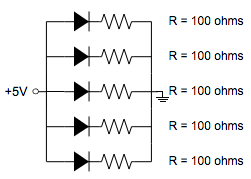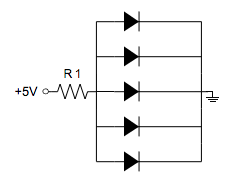This is the second part in a a multi-part series on how to wiring LEDs.
Wiring LEDs in parallel can be very similar to wiring single LEDs. Really, it is simply "tying" all of your single LEDs together and using a common + and - to power them. There are a couple ways to wire LEDs in parallel. One of them is not one we usually recommend, however there are circumstances where it may be your only option. Ideally, every LED should have its own resistor. This will ultimately allow the LEDs to have a more consistent current across the array when wiring in parallel.

 [/caption]
[/caption]
What are some reasons why you would want to wire LEDs in parallel?
- If you want to keep things fairly simple and don't want to worry about different or more complex configurations. We find this to be one of the most common reasons.
- You don't have enough voltage with your power supply to power more than one LED in series.
- It is quicker to wire them in your scenario than any other way
Important things to note about wiring LEDs in parallel
- As you add LEDs to your parallel array, the voltage requirements stay the same.
- As you add LEDs to your parallel array, the current requirements increases the amount that each LED requires (5 LEDs @ 20mA = 100mA requirement/draw).
- If you use just a single resistor for the whole array then each LED must be exactly the same, no mixing colors or other LEDs.
Scenario 1
We have a 5v Power Supply and we want to power 5 Green LEDs. In this example, we will use this LED: By looking at the specification for this LED, we know that it requires about 20mA @ 3.0v. Since we don't have enough voltage to wire any of them in series, the only option is to wire them in parallel. The voltage requirement for this setup is still 3.0v, however we need a power supply that can supply at least 100mA (5 LEDs x 20mA each LED). Our power supply that we will use is this one:. One of the common misconceptions that we hear is trying to match the LEDs to the power supply current. Since this is a constant voltage power supply then it will always put out 5v, however it doesn't always put out 1000mA. It has the ability to supply up to 1000mA based on what the load is (our LED array). Since our LEDs will only need 100mA then this is a great power supply. On to the resistor selection. We know that having a resistor for each LED will be the best scenario. We can calculate the resistor needed in the exact same way we did for the "Single LED Wiring" part of this series. I have copied the procedure down here to make it easier. I have also adjusted then numbers for a 5v power supply too. Formulas for LED Resistor Selection V=IR (Voltage = Current x Resistance) P=IV (Power = Current x Voltage) Power is measured in Watts Current is measured in Amp or milliamps (mA) Resistance is measured in Ohms Calculating Resistance Value Rearranging the first formula to solve for resistance we get the following: R = V/I If we solve for Resistance then we get something like this: R = (5v - 3v) / .020A R = 100 Ohms The voltage value needs to be what is left over AFTER the LED's needs. In this case, our maximum voltage is 5v because it is from a regulated power supply. The LED requires 3.0v, so that will leave us with 2v in excess. The LED uses 20mA, which is the same as .020 Amps. The formula works when you use amps. If we divide it out then we get R=100 Ohms This is the resistance value and is very important. We want to choose a resistor with the resistance rating OR HIGHER. Calculating Power Rating for Resistor The next very important part to resistor selection is the power rating of the resistor. This is a rating that states how much power (in the form of heat) a resistor is able to dissipate. Typically the larger difference in voltage between the supply and required amount for the LEDs then the higher the power resistor that is needed. This can also be drastically changed by using higher power LEDs that use more current. P = IV P = .020A x 2v Since this is being calculated for the resistor we have to say that the current going through the resistor is that of the LED (.020A) and the voltage drop is 2v. Solving for P = 0.04 Watts This is less than a 1/4 watt (.25w), so using a 1/4 watt resistor will work perfectly. Remember, going over on the wattage is acceptable and will not make your lights any dimmer. How to Choose an Actual Resistor for your LED Choosing the correct resistor. Take a look at the list of values and you will see that 100 Ohm is an option, so we can choose that exact resistor. If it wasn't an option then you would choose the next highest option. That would be the best resistor selection for this scenario: 100 Ohm 1/4 watt resistor. This will provide a very long life for the LED array. Now let's actually wire them up.
Scenario 2
This is the second scenario that we typically don't recommend, but do often times get asked about. Can you use a single resistor for all your LEDs? You can, but we will hesitantly recommend it if it is the only option. Sometimes there is a situation where you can only wire LEDs in parallel and you are not able to put a resistor on each LED. This could be due to space. In this situation this may be your only option, which is better than not having LEDs. We will take the same 5 green LED setup and 5v power supply, but this time we will calculate it using just ONE resistor. We apply all of the same formulas and information as before except we change one important aspect. We have to treat all 5 LEDs as a "single" LED for our calculations. You have to use the same exact LEDs in the parallel circuit this way or the distribution of current will not be proper across all the LEDs and will throw everything off. Here are the basic formulas again. Formulas for LED Resistor Selection V=IR (Voltage = Current x Resistance) P=IV (Power = Current x Voltage) Power is measured in Watts Current is measured in Amp or milliamps (mA) Resistance is measured in Ohms Calculating Resistance Value Rearranging the first formula to solve for resistance we get the following: R = V/I Our LED information is based of the entire parallel structure we are making. We have 5 LEDs that consume 20mA at 3.0v. The forward voltage is still 3.0v because that doesn't change in a parallel configuration. Each LED will draw 20mA and there are 5, so we have to add those up. 5 x 20mA = 100mA. We will now essentially treat this as a single 3.0v LED that draws 100mA. If we solve for Resistance then we get something like this: R = (5v - 3v) / .100A R = 20 Ohms The voltage value needs to be what is left over AFTER the LEDs' needs. In this case, our maximum voltage is 5v because it is from a regulated power supply. The LED requires 3.0v, so that will leave us with 2v in excess. The LED uses 100mA, which is the same as .100 Amps. The formula works when you use amps. If we divide it out then we get R=20 Ohms This is the resistance value and is very important. We want to choose a resistor with the resistance rating OR HIGHER. Calculating Power Rating for Resistor The next very important part to resistor selection is the power rating of the resistor. This is a rating that states how much power (in the form of heat) a resistor is able to dissipate. Typically the larger difference in voltage between the supply and required amount for the LEDs then the higher the power resistor that is needed. This can also be drastically changed by using higher power LEDs that use more current. P = IV P = .100A x 2v Since this is being calculated for the resistor we have to say that the current going through the resistor is that of the LED (.100A) and the voltage drop is 2v. Solving for P = 0.2 Watts This is less than a 1/4 watt (.25w), so using a 1/4 watt resistor will work, however since it is fairly close, I would recommend bumping up to a 1/2w. Remember, going over on the wattage is acceptable and will not make your lights any dimmer. Looking at the 1/2 watt resistor page, we can see that the value closest to 20 ohms without going under is a 22 ohm 1/2 watt resistor. This would be the best resistor to choose. Here is how to wire them up in this configuration: [caption id="attachment_149" align="aligncenter" width="250" caption="How to wire LEDs in parallel with only one resistor"] [/caption]
[/caption]
